Watch green comet near Mars today with free telescope livestream
If you can't make it outside or if cloudy skies block your view, you can still catch a glimpse of comet C/2022 E3 (ZTF).

The green comet C/2022 E3 (ZTF) has a few more chances to wow skywatchers before it potentially leaves the solar system.
The comet is primed for early evening viewing right now, appearing close to the Auriga and Taurus constellations throughout early February. On Thursday (Feb. 9), the comet will begin approaching Mars in the night sky, beside which it will remain for the next four or five nights. If you haven't gotten out to observe the comet with binoculars or a telescope yet, this week could offer a prime opportunity, as Mars can make for an easy-to-find reference point in the sky.
If you can't make it outside or if cloudy skies block your view, you can still catch a glimpse of comet C/2022 E3 (ZTF)'s close approach to the Red Planet, thanks to the Virtual Telescope Project. Astronomer Gianluca Masi will host a free livestream of the comet as it approaches within 1 degree of Mars on the project's website and YouTube channel. (Your clenched fist held at arm's length covers about 10 degrees of sky.) The livestream will start at 2:00 p.m. EST (1900 GMT) on Saturday (Feb. 11).
Related: See the green comet near Mars in the night sky this week
Read more: How to view and photograph comets

Looking for a telescope to see comet C/2022 E3 (ZTF) near Mars? We recommend the Celestron Astro Fi 102 as the top pick in our best beginner's telescope guide.
Comet C/2022 E3 (ZTF) was discovered in March 2022 by two astronomers at the Zwicky Transient Facility at the Palomar Observatory in California while it was just inside the orbit of Jupiter, 399 million miles (643 million kilometers) away from the sun. Originally thought to be an asteroid, the comet shortly after identified itself with its coma, the cloud of dust and ice surrounding its nucleus. As it has made its way through the inner solar system, the comet has put on quite a show for astrophotographers.
In addition to the livestream of the comet as it approaches Mars, the Virtual Telescope Project has previously hosted webcasts of the comet at perihelion, its closest point to the sun, and perigee, its closest approach to Earth.
While not quite bright enough to be seen with the unaided eye in most locations, the comet is currently easily viewable through binoculars or a telescope. I have personally observed it through both, and found both views enjoyable. If you venture out to see it for yourself, just don't expect to see the bright green, well-defined views that astrophotographers have achieved; those images are usually taken on high-end equipment and are produced by laying multiple long-exposure photographs over one another.
Get the Space.com Newsletter
Breaking space news, the latest updates on rocket launches, skywatching events and more!
Through a beginner-level 4.5-inch tabletop telescope at 35x magnification, I have been able to make out the nucleus and coma quite easily most nights. At this level of magnification, the comet appears almost like a "hairy" or cloudy star. Higher levels of magnification on a more sophisticated telescope can bring out more detail. No matter what level of optics you have, the comet should make for an enjoyable sight.

If you want to see comet C/2022 E3 (ZTF) near Mars this week and don't have the right gear, be sure to peruse our guides for the best binoculars and the best telescopes to view the comet or anything else in the sky. For capturing the best comet images you can, we have guides on how to view and photograph comets and the best cameras for astrophotography and best lenses for astrophotography.
Editor's Note: If you photograph comet C/2022 E3 (ZTF) near Mars this week and would like to share it with Space.com's readers, send your photo(s), comments, and your name and location to spacephotos@space.com.
Follow Brett on Twitter at @bretttingley. Follow us @Spacedotcom, or on Facebook and Instagram.
Join our Space Forums to keep talking space on the latest missions, night sky and more! And if you have a news tip, correction or comment, let us know at: community@space.com.

Brett is curious about emerging aerospace technologies, alternative launch concepts, military space developments and uncrewed aircraft systems. Brett's work has appeared on Scientific American, The War Zone, Popular Science, the History Channel, Science Discovery and more. Brett has English degrees from Clemson University and the University of North Carolina at Charlotte. In his free time, Brett enjoys skywatching throughout the dark skies of the Appalachian mountains.
-
cozmicray You may also see comet C 2022 E3 ZTF at Skytour Live stream on youtubeReply
https://www.youtube.com/@STLS/streams
tune in to live stream or look at past recordings of comet observation
https://skytourlive.com/ -
rod I did view the comet again this evening in Taurus.Reply
Observed 1900-1940 EST. Last Quarter Moon 13-Feb-2023 1601 UT. Waning gibbous Moonrise tonight in Virgo 2128 EST. C/2022 E3 (ZTF) easy to see using 10x50 binoculars tonight, located in Taurus. Mars and C/2022 E3 (ZTF) angular separation about 4-degree 46 arcminutes according to Stellarium 1.2. The comet was nearly mid-way between Hassaleh in Auriga and Mars in Taurus. A distinct fuzzy coma visible in my 10x50 binocular view. I am slowly saying goodbye to this comet as it heads out towards places unknown :) Stellarium 1.2 shows distance from Earth to C/2022 E3 (ZTF) tonight about 0.396 au. Distance to Mars, 0.959 au, and distance to Hassaleh in Auriga, 493.43 ly. An easy observing time this evening using 10x50 binoculars, theskylive.com reports 6.3 magnitude for C/2022 E3 (ZTF) tonight. Stellarium 1.2 shows 6.29, and Starry Night Pro Plus 8 shows 6.29 magnitude. I viewed the comet periodically since 24-Dec-2022. Starry Night Pro Plus 8 Sky Calendar says for 10-Feb-2023. "Comet C/2022 E3 (ZTF) Meets Mars (evening) VIEW On Friday night, February 10, the path of Comet C/2022 E3 (ZTF) is predicted to carry it closely past the bright red planet Mars. The pair will be positioned nearly overhead in the southwestern sky, between the very bright stars Aldebaran in Taurus, the Bull and Capella in Auriga, the Charioteer. Mars and the comet will be close enough to share the field of view in binoculars and widefield telescopes. The comet will have faded from its predicted peak brightness, but it should still be visible in binoculars. Comet C/2022 E3 (ZTF) will be closest to Mars during the hours around 7 a.m. EST (or 11:00 UT on February 11), but it will have set by 3 a.m. local time in the Americas." -
rod Well, some more comet viewing tonight, this time closer to Mars in Taurus now :)Reply
Observed 1900-1945 EST. Last Quarter Moon 13-Feb-2023 1601 UT. Waning gibbous Moonrise tonight in Virgo 2231 EST. C/2022 E3 (ZTF) easy to see using 10x50 binoculars tonight, located in Taurus. Mars and C/2022 E3 (ZTF) angular separation about 1-degree 41 arcminutes according to Stellarium 1.2. A distinct fuzzy coma visible in my 10x50 binocular view, brighter nucleus, still a good size in my binocular view. Stellarium 1.2 shows distance from Earth to C/2022 E3 (ZTF) tonight about 0.419 au. Distance to Mars, 0.969 au. I could see the comet and Mars together in the binocular view. Perhaps some will get a photo of this pairing tonight, theskylive.com reports 6.5 magnitude for C/2022 E3 (ZTF) tonight. Stellarium 1.2 shows 6.44. Some altocumulus and cirrus clouds moved in, so I did not use my telescopes (90-mm refractor or 10-inch Newtonian.) Temperature 8C, winds 360/8 knots. I did see the comet closer to Mars position tonight and that was enjoyable using binoculars, both visible in the binocular view.









